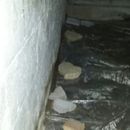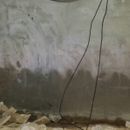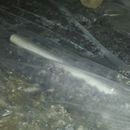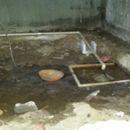Questions about sealing/converting a vented crawl space
We are purchasing a house that has a crawl space (actually two, connected by an access door/hatch). We’ve owned a number of houses but never had one with a crawl space. There were some moisture issues evident in the inspection so I’ve been reading various articles (GBA and others) on crawl spaces and am fairly certain I will want to convert to an un-vented/conditioned crawl space but there are a number of concerns/questions I have.
Background:
The house is in zone 6b and was built in 1979. An addition was built in 2010. Both sections have a crawl space with between 4′ and 6′ between the crawl space floor and the floor joists above. Under the original structure, the floor is full of debris…rock, dirt, broken concrete, large in-tact sections of what appear to be an old rat slab. It does not have a vapor barrier. It has a floor drain that runs under both crawl spaces and out to a dry well that has a sump pump installed in it to pump water off to a nearby creek. The current owners have a humidifier in there that appears to run constantly and a condensate line and discharge from a water softener both run to the floor drain. The crawl space in the newer section has 6-mil poly on the floor that runs to the walls and is held in place with rocks along the wall. It also has a radon vent under the poly.
I inquired a/b the debris under the original structure and was told by the current owner that it was like that when they bought the house in 2003 and that they believe there had been an older, demolished structure and that this house was built over the foundation.
The moisture issues included a pool of standing water around the drain, a damp floor — in the low areas, and walls that were as much as ~40% damp up from the floor. The inspection was conducted following two weeks of snow melt and two days of very heavy rains. I was fortunate to have an inspection at a time that was probably very close to worse-case-scenario in terms of water. The current owners have a dehumidifier in there that appears to run constantly and, apparently the breaker for the sump pump in the dry well had been kicked which resulted in the pool of water. When I returned a few days later, the crawl space was very dry.
The older crawl space had faced fiberglass batts between the floor joists, none of which were sagging or appeared to be affected by moisture. Also, there wasn’t any evidence of rot in any of the wood, nor did I see any mold. The newer section had unfaced fiberglass batts.
My questions:
– I’ve read that not all crawl spaces are “eligible” for conversion to sealed/unvented/conditioned…why would that be?
– I assume I would have to remove the debris from the older section and use fill to level the floor to make it suitable for poly. What should I use to fill and level, something like crushed stone or gravel?
– If I lay a poly vapor barrier in the older crawl space, should it be over or around the drain?
– I know the moisture on the walls is a problem. There were plenty of opportunities to better manage storm water and minimize water around the foundation through grading, running downspouts away from the house, etc. I think these would reduce but not eliminate the problem. I was also thinking I would use Drylok on the walls to further reduce the moisture. Good idea or not?
– If I run poly in both crawl spaces up the walls, seal the seams, etc, are there any issues with simply running it over the existing poly in the newer section?
– If I were to insulate the walls with rigid foam and run poly up the walls, which side of the poly does the insulation go on?
– I’ve seen the Tu-tuff poly recommended but I’ve also seen that poly should be at least 6-mil. Tu-tuf appears to be 4-mil…do they make it thicker?
– Is there any problem running a pipe for radon in the older crawl space and just connecting it to the same stack that the pipe from the other connects to?
GBA Detail Library
A collection of one thousand construction details organized by climate and house part













Replies
Scott,
Q. "I've read that not all crawl spaces are eligible for conversion to sealed/unvented/conditioned...why would that be?"
A. If a crawl space is wet enough to develop puddles on the floor, as yours appears to be, it is best to remedy the moisture entry issues before proceeding with the steps required to create a sealed, conditioned crawl space. I recommend that you read this article: Fixing a Wet Basement. Although that article is about basements, not crawl spaces, most of the advice in that article is relevant to your situation.
Q. "I assume I would have to remove the debris from the older section and use fill to level the floor to make it suitable for poly. What should I use to fill and level, something like crushed stone or gravel?"
A. Yes. Sand would also work. However, it's often better to make a level grade by lowering the high spots (digging them out) than by filling in the low spots.
Q. "If I lay a poly vapor barrier in the older crawl space, should it be over or around the drain?"
A. Around. If you decide that your crawl space needs a drain, the grade of the crawl space should slope toward the drain, so that the drain is located at the lowest spot, and there should be a hole in the poly at the drain location. Even better would be to install a concrete "rat slab" over the poly, with a proper drain set into the concrete.
Q. "I was thinking I would use Drylok on the walls to further reduce the moisture. Good idea or not?"
A. The use of products like Thoroseal, UGL Drylok, and Xypex are discussed in my article, Fixing a Wet Basement.
Q. "If I run poly in both crawl spaces up the walls, seal the seams, etc, are there any issues with simply running it over the existing poly in the newer section?"
A. Not really, as long as the old poly is dry.
Q. "If I were to insulate the walls with rigid foam and run poly up the walls, which side of the poly does the insulation go on?"
A. On the interior side. However, if you install rigid foam on your walls, it's possible to omit the poly on the walls. Either way will work.
Q. "I've seen the Tu-tuff poly recommended but I've also seen that poly should be at least 6-mil. Tu-tuf appears to be 4-mil...do they make it thicker?"
A. I don't think so. Tu-Tuff is reinforced, so the 4-mil Tu-Tuff performs as well as, or better than, ordinary 6-mil polyethylene.
Q. "Is there any problem running a pipe for radon in the older crawl space and just connecting it to the same stack that the pipe from the other connects to?"
A. Assuming that the pipe that you call "the same stack that the pipe from the other connects to" is actually the vented riser for a radon mitigation system, no. However, there are a lot of variables when it comes to the design of radon mitigation systems. If you have any doubts, it's always best to test your indoor air for the presence of radon. For more information, see All About Radon.
A final piece of advice: if you haven't seen it, I recommend that you read Building an Unvented Crawl Space.
Thank you, Martin.
Leveling the crawl space will likely be a combination of removing debris, building up low areas, and digging out, as you suggested. I would think that leveling to the edge of the footing would facilitate laying the vapor barrier, no?
I visited the property again and had an opportunity to talk to the current owner. He actually installed drain tile around the addition which drains to the dry well. He also capped the ends below the surface, intending to extend the drain tile around the full perimeter. There are even a couple of downspouts that he ran drainage pipe to (under the surface) and never got around to actually connecting. All that said, I think I'll have a relatively easy task of improving the storm water management and significantly remediating the moisture problems in the crawl space. In reading your "Fixing a wet basement" article, it sounds like using Drylok will help too.
As much as I'd like to pour a rat slab, I suspect that will be out of my budget. The drain will need to remain, as long as the water softener and HVAC condensation line are draining there. If radon is a concern, what is the best way to make the drain "proper", absent the rat slab?
Thanks, again!
Scott,
Q. "If radon is a concern, what is the best way to make the drain proper, absent the rat slab?"
A. I'm not sure. You might want to contact a radon mitigation contractor and ask for advice.